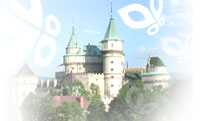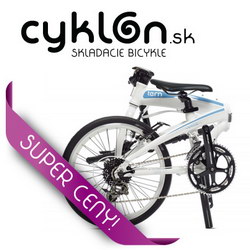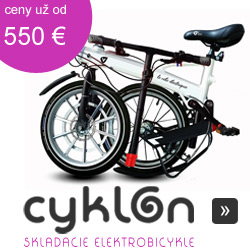

 |
 |
|
| Slovakia´s best facts history UNESCO sights nature sights gastronomy spas swim cyclistics skiing |
TOWNSTowns in Slovak regions:
B R A T I S L A V A r e g i o nBRATISLAVA
Founded before the 10th century, the city was known originally as Pressburg. Strong fortifications erected during the 12th century gave it strategic importance; from 1541 to 1784 it was the capital of Hungary In 1805, during the Napoleonic War, French Emperor Napoleon I met the Holy Roman Emperor Francis II in the Primate's Palace (pictured at left) and imposed the peace terms known as the Treaty of Pressburg. When Czechoslovakia was created in 1919 after World War I, the city was renamed Bratislava and made capital of the province of Slovakia. The old city and the castle are the best parts of Bratislava. The old city is packed with museums (such as the Municipal Museum which comes complete with torture chambers and the Museum of Wine Production) andpalaces (Primate's Palace and the Mirbach Palace). The castle, built above the Danube, was a frontier post of the Roman Empire from the 1st to the 5th century. Since the 9th century it has been rebuilt several times, most recently between 1953 and 1962. Climb up for the great views and to check out the very interesting Museum of Folk Music within. The Slovak National Museum and the Slovak National Gallery on the river are also worth a visit. Hviezdoslavovo namestie (square) is a convenient orientation point, with the old town to the north, the Danube to the south, and Bratislava Castle to the west. More info: www.bratislava.sk, www.bratislavacity.sk T R N A V A r e g i o nTRNAVA
Trnava is an important center of West Slovakia and is one of Slovakia's oldest cities (13th century). It was, during the period of the Turkish invasions, a religious center of Hungary, and became, as early as the 17th century, a university town. Numerous buildings from this era earned Travna the nickname of "The Slovak Rome". This historic center was surrounded by medieval town walls (Gothic). The old university occupies the northwestern part of the Old Town. The visitor can also admire the Clarist convent, the University Church of St. John the Baptist and the Franciscan Church of St. James. The Cathedral of St. Nicholas, constructed in the area around the fortifications in the second half of the 14th century, deserves special attention. There are several other churches to visit in the city and also the Archbishop's Palace. More info: www.trnava.sk N I T R A r e g i o nNITRA
Nitra is one of the oldest town settlements in Slovakia. As early as the 9th century, it was a princely seat and bishopric of the Great Moravian Empire and later it welcomed the pretender to the throne of Hungary. In 830, the first Christian church in Slovakia saw the light of day there. Nitra became an independent royal town in 1248. It suffered from several Turkish invasions. The Nitra Castle is the most visited monument in the city. The Upper Town is comprised of a harmonious group of particularly well-preserved historical buildings. There is a Franciscan Church, burgher houses and an art gallery. A permanent exhibition at the Nitra Museum shows the history of the city, its surrounding areas and Slovakia. The Nitra State Gallery, the Gallery of the Young, and the Art Gallery present Slovakian works as well as temporary exhibitions by foreign artists. The cultural life in Nitra is very rich.
T R E N C I N r e g i o nTRENCIN
Originally a Roman military colony, the city of Trencin was founded at the beginning of the second millennium. In 1412, it acquired the rights of a free royal city. The high point of Trencin is the fortified castle which overlooks the city. Its construction probably goes back to the 11th century and building continued until the 14th century. It became the property of Matus Cak, a prominent Slovak historical figure, who ordered the construction of the Tower which carries his name and which is today, one of the symbols of the city. The castle has been renovated and is in excellent condition. Exhibitions are organized here as well as medieval music, classical and folkloric concerts plus medieval shows. The castle can also be visited at night. The fortified castle was built on a huge rock, on which a Roman inscription testifies to Trencin's history. On the hills leading to the castle is the beautiful Catholic Parish Church of the Virgin Mary. In the center of the Old Town is Peace Square (Mierove Namestie) where you will find a column erected in 1713 during the plague epidemics. Around the Square is the Trencin Museum as well as a 19th century synagogue built not far from the Piarist Church, next to which is a former monastery which today houses the Gallery of M.A. Bazonvky, a modern painter. More info: www.trencin.sk Z I L I N A r e g i o nZILINA
Zilina is a city located in the center of Northwest Slovakia at the confluence of the Vah and the Kysuca. By population, it is the third largest city of Slovakia. The most well-known monument in the city and the surrounding areas is the Budatin Castle, located to the north of the town, above the two rivers. The town square is surrounded by arcaded burgher houses from the 16th and 17th centuries. The Church of the Holy Trinity, next to which is a Renaissance belfry, the Burian Tower (1530), dominates the Old Town. More info: www.zilina.sk MARTIN
Martin is a city which took on particular importance from a historical and cultural point of view in Slovakia. In the 19th century, a turning point in Slovakian history, Martin was the center of cultural life in the country. It became the symbol and the center of a national movement which founded the "Matica slovenska", a foundation devoted to education and culture, literature and the arts. In June 1861, the "Martin Memorandum" of the Slovak Nation was issued as well as the "Martin Declaration" of the Slovak Nation in 1918. Several remarkable monuments can be found in Martin, among which are the Matica Slovenska building, the National Museum, the National Cemetary and the Janosik Fountain. Several well-known historical figures lived in this remarkable city. Pictorial art lovers can admire the works of Martin Benka, one of the most talented 20th century painters. More info: www.martin.sk B A N S K A B Y S T R I C A r e g i o nBANSKA BYSTRICA
This is the administrative, economic and cultural center of Central Slovakia. A national cultural monument dominates the city center. The Church of our Lady is the oldest building. It is characteristic of the change in European architectural styles. Banska Bystrica is certainly one of the Slovakian cities with the richest architecture. The center of the city is exceptional. Among the many monuments and buildings (it would be impossible to present a complete list here) is the Clock Tower which, like the Tower of Pisa, leans; The city houses several art galleries and museums, including the SNP Museum which commemorates the resistance to Nazi oppression. Banska Bystrica is, because of its cultural richness, the pearl of Central Slovakia More info: www.banskabystrica.sk, www.bbb.sk BANSKA STIAVNICA
Banska Stiavnica is the old mining town, with numerous beautiful monuments. From 13th to the 18th centuries is the town most important mining centre with the deposit of precious metals. The extraction and processing of precious metals, especially gold and silver, goes back to the Bronze Age. Banska Stiavnica is also known for its Mining Academy founded in 1762 as the first institution of higher education of its kind in the world More info: www.banskastiavnica.sk, www.uakom.sk/bs/bans_hist.html KREMNICA
A visit to Kremnica usually begins at the Lower Gatehouse. The sloping regular square with the Holy Trinity Plague Column affords a nice view of the imposing castle. History - lovers may visit several attractive museums, they will go to the Franciscan church to admire its interior. To reach the square from another side, they may go accross the site of the former Upper Gatehouse behind the mint. More info: www.kremnica.sk K O S I C E r e g i o nKOSICE
Kosice is the center of East Slovakia. This city, the second largest in Slovakia, has a long and rich history. In the town center is the magnificent Gothic cathedral, the Cathedral of St. Elizabeth, as well as the Chapel of St. Michael, the Urban Tower and the Neo-Baroque State Theatre where famous orchestras perform. The Katova Citadel and the Mlynska Citadel are witnesses to the ancient system of fortifications for protecting the city against its enemies. The visitor can also discover the beauty of several other monuments and buildings of great cultural and historical interest (the old Town Hall, the old University, the Captain's Palace, Liberation Square, etc.) as well as several galleries and museums (the East Slovak Museum). The visitor can relax in the quiet of Municipal Park located in the area around the city center. More info: www.kosice.sk, www.cassovia.info P R E S O V r e g i o nPRESOV
Presov is an important cultural and historical center in East Slovakia. A Slav settlement, it saw the arrival of Hungarian and German colonialists and then went through a tumultuous period, notably in the revolutionary years of 1848-9. The elliptical shaped historical core of the city has been preserved and a part of the fortifications still exist today. The town center is decorated with dozens of Renaissance-style homes. Several important monuments can be found on the town square. The Gothic Cathedral of St. Nicolas, dating from the 14th century, and the Evangelical Church, built around 1650 are remarkable for their interior decoration. In the middle of this same square is the imposing Neptune Fountain and a group of statues. The presence of a richly decorated Baroque palace should also be mentioned. Presov is also known for its floral decorations. More info: www.pis.sk BARDEJOV
Prve písomne zmienky sú z r. 1241 a rozsiahle privilegia dostalo mesto v r. 1352, co pomohlo rychlejsiemu osídľovaniu. Slobodnym kraľovskym mestom sa stalo v r. 1376. Vďaka rozvoju remesiel, obchodu, cechov, skolstva a kultúry sa stal Bardejov v stredoveku vyznamnym mestom Uhorska. Zlaty vek zaznamenal Bardejov v 15. st., v ktorom sa rozvinula aj kultúra vďaka reformistovi Leonardovi Stöckelovi, rektorovi Humanistickeho gymnazia. V tom case boli zriadene aj prve kníhtlaciarne. V Bardejove sa nachadza 131 kultúrnych pamiatok a 1 narodna kultúrna pamiatka. Najcennejsou architektonickou pamiatkou je neskorogoticka bazilika sv. Egídia zo 14. st. V interieri trojloďovej baziliky sa zachovalo 11 pôvodnych gotickych krídlovych oltarov. Krídla tvoria tabuľove maľby zobrazujúce život svätca, ktoremu bol oltar zasväteny. Stredoveka radnica z r. 1505 - 1511 bola prvou renesancnou stavbou na Slovensku. Rímsu radnice zdobí 118 kamennych plastík. V interieri je zachovany vzacny kazetovy strop a intarzovane dvere do radnej miestnosti. K cennym pamiatkam sa radí aj fortifikacny system ktory mal 23 bast, z ktorych sa 12 zachovalo a zatiaľ je zrekonstruovanych 9 bast a 2 barbakany. Nesporne unikatnou pamiatkou je židovske suburbium, ktore tvorí komplex samostatnych budov. Tvorí ho cely areal stavieb: hlavna synagóga, modlitebňa, miestnosti pre zhromažďovanie veriacich, skola, ritualne kúpele a jatky. V synagóge sa zachovali nastenne maľby s rastlinnymi motívmi z 19. st. More info: www.bardejov.sk, www.e-bardejov.sk KEZMAROK
Mesto vzniklo z Moreerych osad pôvodneho slovanskeho obyvateľstva a nemeckych kolonistov. Kežmarok získal mestske prava v r. 1269 a slobodnym kraľovskym mestom sa stal v 15.st. Mesto bolo casto nicene vojnami. Celkovo preslo cez chotar Kežmarku 13 vojen, pocnúc husitmi a konciac armadami II. sv. vojny. Na jeho území sa dnes nachadza 256 kultúrnych pamiatok a 2 narodne kultúrne pamiatky. K najvyznamnejsím pamiatkam patrí barokovy dreveny artikularny kostol z r. 1717 a budova lycea z r. 1774. V budove lycea je najväcsia skolska historicka knižnica v strednej Európe. Z ďalsích architektonickych zaujímavostí je dôležite spomenúť radnicu z r. 1461, kostol sv. Kríža z 15. st. a zakladmi z 13. st. Kežmarsky zamok z r. 1463 vznikol na troskach neskoromanskej osady, jej kostola a klastora sv. Alžbety. Presiel Moreerymi úpravami v 16. a 17. st., odkedy ma dnesnú podobu. V súcasnosti je sídlom rôznych historickych expozícií. Uchovane sú aj zvysky mestskeho opevnenia zo 14-16. st., zvonica z r. 1591, paulínsky kostol z r. 1650, reduta z r. 1818 a novy evanjelicky kostol z r. 1894, v ktorom je dnes mauzóleum Imricha Thökölyho, majiteľa kežmarskeho hradu a veliteľa jedneho z povstaní uhorskej sľachty. Kežmarska hradna pani Beata Laski uskutocnila s Moreerymi spolocníkmi cez turícne sviatky v r. 1565 prvy historicky znamy turisticky vylet do Vysokych Tatier, do Doliny Bielej vody a položila tak zaklady histórie tatranskej turistiky. More info: www.kezmarok.sk, museum www.kezmarok.com LEVOCA
Pred vznikom stredovekeho mesta Levoca bolo na jeho území niekoľko starsích slovanskych osad. Už v 12. st. obchodovali s Krakovom, hansovnymi mestami i s Benatkami. Najvyznamnejsie cechy mali zlatníci, medirytci a cíniari. V 15. st. pribrzdili hospodarsky rozkvet husitske najazdy a negatívne pôsobila aj 100 rocna vojna s Kežmarkom. Mestska pamiatkova rezervacia Levoca predstavuje uceleny súbor vyznamnych kultúrno-historickych pamiatok ohraniceny obdĺžnikom pomerne zachovanych mestskych hradieb. Nachadza sa tu 339 kultúrnych pamiatok a 2 narodne kultúrne pamiatky. Azda najcennejsím architektonickym dielom je Narodna kultúrna pamiatka goticky kostol sv. Jakuba zo 14.st. postaveny na mieste starsieho kostola. Mimoriadne cenny je interier, ktory je jedinecnym múzeom stredovekeho sakralneho umenia. Jeho neskorogoticky 18,6 m hlavny oltar je najvyssím svojho druhu na svete. Je z lipoveho dreva a bol vyrobeny v rokoch 1507 - 1517 rezbarom Majstrom Pavlom z Levoce. Vyznamnou stavbou je aj levocska radnica s arkadami z r. 1550. Sú v nej zbierky Spisskeho múzea. Klasicisticky evanjelicky kostol z 19. st. v južnej casti namestia postavili na mieste starsej drevenej stavby. Pozoruhodnou je budova obchodneho domu Waaghaus (mestske vahy) z r. 1588. Susedny župny dom v empírovom slohu je z r. 1805. Pozornosť na prvy pohľad upúta aj Thurzov dom, ktory získal novorenesancnú sgrafitovú fasadu v r. 1904. V mestianskom dome c. 26 sídlila Breuerova tlaciareň. Slavna rezbarska dielňa Majstra Pavla je vo dvore domu c. 20, kde je zaroveň expozícia Spisskeho múzea. V susedstve Poľskej brany stojí gymnazialny kostol a klastor minoritov. Pri Kosickej brane sa nachadza novy klastor minoritov a kostol sv. Ducha od roku 1753. Vysoko nad mestom sa tyci Marianska hora (781 m), kde je neogoticky kostol navstívenia Panny Marie zo zac. 20. st. Každorocne sa pri ňom kona zaciatkom júla najväcsie stretnutie pútnikov na Slovensku. V minulosti bolo na Marianskej hore hradisko a v 13. st. poskytovalo opevnene sídlo ležiace vysoko nad okolitou regioninou miestnemu obyvateľstvu bezpecne útocisko pred tatarskymi hordami. Vďacní Levocania na tomto mieste postavili pútnickú kaplnku. Stalo sa tak pravdepodobne v druhej polovici 13. st. V 14. st. ju prebudovali na mensí goticky kostol. More info: www.levoca.sk SPISSKA KAPITULA
Postavenie cirkevneho centra Spisa ma už od konca 12. st. Osada na mieste Spisskej Kapituly vznikla už v 11. st. v susedstve benediktínskeho klastora. Najvyznamnejsou stavbou Spisskej Kapituly je neskororomanska katedrala sv. Martina. Podobu mohutnej trojloďovej stavby s dvoma vežami nadobudla v rokoch 1245 - 1275. V r. 1382 k nej pristavali kaplnku Corpus Christi, ktorú v r. 1488 - 93 nahradili súcasnou kaplnkou Zapoľskych. Pred zapadnym priecelím katedraly stojí socha sv. Jana Nepomuckeho z r. 1732. Biskupsky palac postavili zaroveň s katedralou este ako prepostsky palac. Od roku 1281 presiel niekoľkymi renesancnymi a barokovymi úpravami. Zaujímavou je aj Hodinova veža z r. 1739. Budova byvaleho seminara pochadza z r. 1647. Vo vychodnej casti Spisskej Kapituly sa nachadzajú domy kapitulskych kanonikov sprístupnene jedinou ulickou. Opevnenie cirkevneho mestecka s dvoma vstupnymi branami postavili v 14. st. a Morekrat ho prestavali. SPISSKA SOBOTA
Spisska Sobota je miestna casť Popradu. Je jeho najzaujímavejsia a z historickeho hľadiska najvyznamnejsia casť. Nachadza sa asi 1,5 km od centra Popradu. Pôvodne trhove osídlenie vzniklo pravdepodobne na strategicky vyhodnej polohe, maďarsko-poľskej spojnici a na križovatke starej obchodnej cesty na vychod, tzv. Via Magna. Najstarsie uchovane písomne dokumenty sú z r. 1256, kde ju uvadzajú ako Forum Sabbathe. Mestecko, ktoremu kraľ Ľudovít I. dovolil pravo konať tyždenne trhy, si dodnes uchovalo stredoveky urbanizmus zastavby sosovkoviteho trhoviska. Nachadza sa tu 89 kultúrnych pamiatok. Medzi najvyznamnejsie kultúrno-historicke zaujímavosti patrí farsky kostol sv. Juraja. Pôvodne neskororomansky objekt bol prestavany v 13. st. a v r. 1273 sa prvy raz písomne spomína. V 15. st. bol kostol opäť prestavany a v 19. a 20. st. restaurovany. Najcennejsím v ňom je neskorogoticky hlavny oltar sv. Juraja z r. 1516 s centralnou plastikou poslednej vecere od Majstra Pavla z Levoce. Ďalsou vzacnou pamiatkou je renesancna zvonica z r. 1598. Odmerka na obilie z r. 1725 je jedinecnou spomienkou a vecnym dôkazom vyznamnych trhov v Spisskej Sobote. Historicky vzacnym je aj farsky dom z r. 1638, v ktoreho interieri sa nachadzajú renesancne a barokove prvky. Vo vychodnej casti mestecka sa nachadza barokovo-klasicisticky evanjelicky kostol z r. 1777. Jeho zachovany interier pochadza z 19. st. Objekt byvalej radnice na namestí bol v r. 1775 prestavany do dnesnej podoby. Neskorogoticky mestiansky dom c. 25 z 15. st. bol v 17. st. renesancne prestavany a v 18. a 19. st. opäť prestavany. More info: www.spsobota.szm.sk |
   |
|